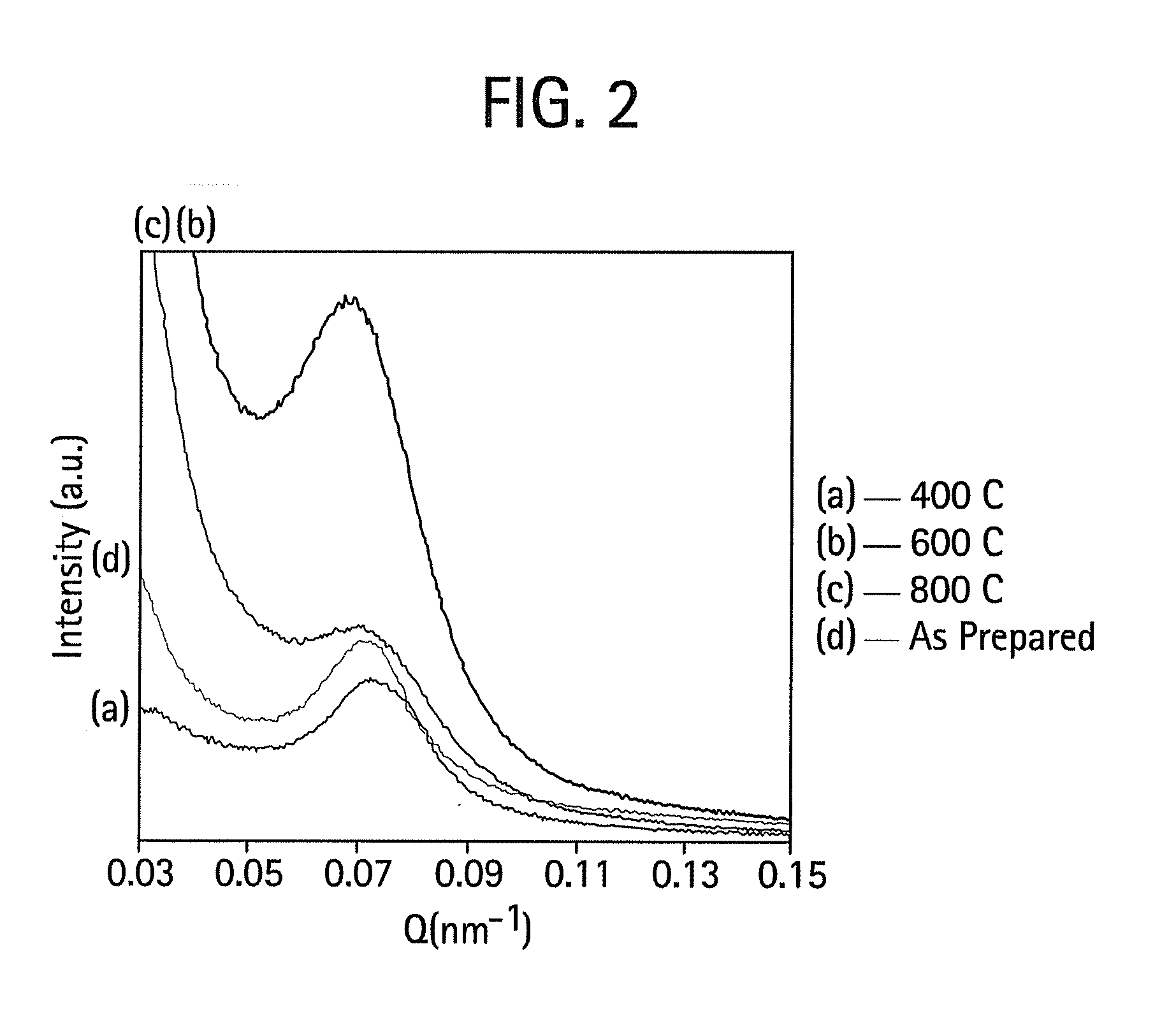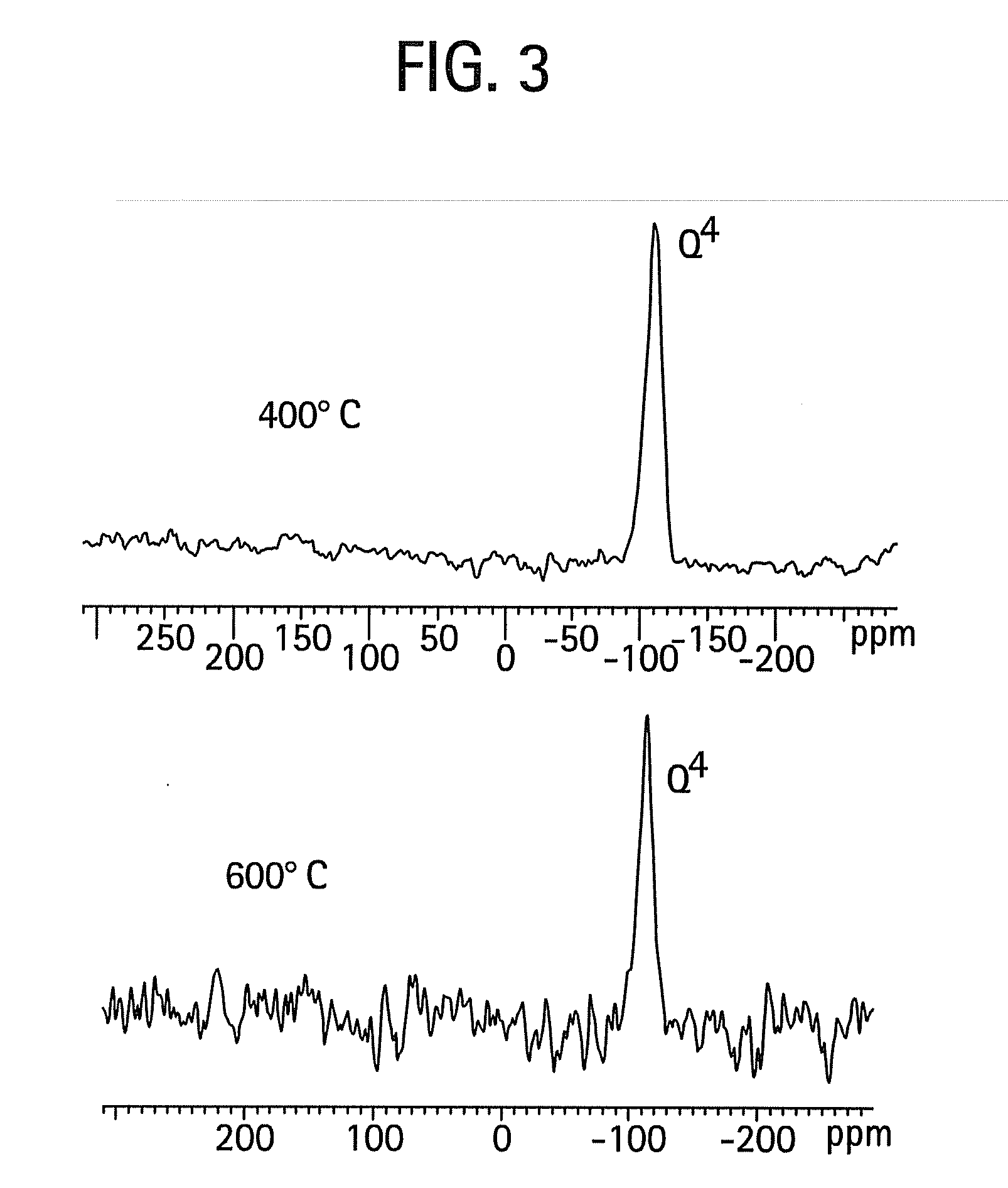Highly condensed mesoporous silicate compositions and methods
a mesoporous silicate and composition technology, applied in the field of high-condensed mesoporous silicate compositions and methods, can solve the problems of significant shrinkage of film or particles, thermal and mechanical stability, and incomplete silicate network formation, and achieve the effect of less shrinkage and condensation and less shrinkage on calcining
- Summary
- Abstract
- Description
- Claims
- Application Information
AI Technical Summary
Benefits of technology
Problems solved by technology
Method used
Image
Examples
example 1
[0039]Cysteamine (0.001 gram) of was dissolved in 100 microliters (μL) of phosphate buffer solution containing 0.01 M potassium phosphate and 0.15 M sodium chloride. In a separate vial, 0.5 gram of Brij 98 surfactant was dissolved in 5 grams of de-ionized water. One hundred (100) μL of each solution were combined in a single vial and vigorously mixed with a vortex mixer. Then, 100 μL of TEOS was added to the solution. The resultant mixture turned white and was mixed vigorously with a vortex mixer. The mixture was allowed to age at room temperature (ca. 24° C.) for approximately three days. The mixture was then centrifuged at about 5000-8000 rotations per minute. The liquid was removed from the centrifuge tube, leaving the solid. The sample was washed three times using de-ionized water as the rinsing agent.
[0040]Organic templates were removed by calcinations at varying temperatures. The most common calcination condition was at 400° C. High temperature calcinations were performed at 6...
example 2
[0042]The procedure of Example 1 was used, except that the structure-directing surfactant was Brij 56 instead of Brij 98. FIG. 5 is a high resolution transmission electron micrograph that shows the selective condensation of silica in a single well-defined domain. Upon calcination at 400° C. there is practically no shrinkage of the silica particle network. FIG. 6 contains SAXS data indicating that there is approximately a 9.2 nm d-spacing for these materials. Again, this thermal stability is believed to derive from the unusually high degree of silica network condensation. There is evidence that this material is virtually all Q4. FIG. 7 shows a 29Si NMR spectrum indicating the high degree of network condensation within the mesoporous silica / surfactant complex as prepared at room temperature and near neutral pH. This complete condensation directly explains the lack of significant shrinkage of the material.
example 3
[0043]This example illustrates the preparation of a mesoporous silicate using a biodegradable structure-directing surfactant. Solutions of 10 milligrams / milliliter cysteamine in PBS buffer and 5 weight percent PLA-PEO-PLA block copolymer (having a poly(ethylene oxy) midblock number average molecular weight of 8,800 atomic mass units and poly(DL-lactide) endblocks each with a number average molecular weight of 5,040 atomic mass units, prepared according to K. A. Aamer, H. Sardinha, S. R. Bhadia, and G. N. Tew, Biomaterials, volume 25, pages 1087-1093 (2004)) in deionized water are prepared at room temperature. The two solutions are then combined in a 1:1 volume ratio. A Teflon™-coated magnetic stir bar is added to the solution. TEOS is then added to form a final volume ratio of 1:1:1. The sample is then agitated at room temperature overnight in an uncovered vessel. The solids in the resulting suspension are then washed with de-ionized water three times and collected by centrifugation...
PUM
| Property | Measurement | Unit |
|---|---|---|
| Temperature | aaaaa | aaaaa |
| Temperature | aaaaa | aaaaa |
| Temperature | aaaaa | aaaaa |
Abstract
Description
Claims
Application Information
 Login to View More
Login to View More - R&D
- Intellectual Property
- Life Sciences
- Materials
- Tech Scout
- Unparalleled Data Quality
- Higher Quality Content
- 60% Fewer Hallucinations
Browse by: Latest US Patents, China's latest patents, Technical Efficacy Thesaurus, Application Domain, Technology Topic, Popular Technical Reports.
© 2025 PatSnap. All rights reserved.Legal|Privacy policy|Modern Slavery Act Transparency Statement|Sitemap|About US| Contact US: help@patsnap.com



